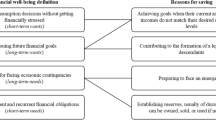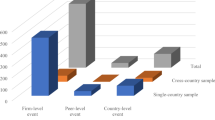Abstract
The current crisis is triggering off a number of overdue reflections and interventions. The need for closer regulation of the financial system is widely perceived to be necessary. That is no doubt necessary, but probably insufficient. A careful overhaul of the functions of the banking and financial system is also needed. Our forefathers, at the time of the Great Depression, were perhaps less demurring to trim a bloated financial system.
Similar content being viewed by others
Notes
See Pasinetti (2007).
Krugman (2009).
See Helpman (2004).
See Sonenscher (2008, p. 192). The idea was that the world had reached the stage, in Mirabeau’s words, of ‘indispensable revolutions, of the collapse and fatal end of the effects of modern politics and their entirely mercantile and fiscal principles’. Physiocracy, the rule of nature, was to provide, Sonenscher continues, the ‘only barrier against this terrifying prospect’: it merely put in analytic and sophisticated form the ‘widely shared view that the modern world’s overcommitment to industry, trade, empire, war and debt could not last’ (ib., pp. 254–255).
Schumpeter (1954, pt. II, Chap. 6, p. 329) wrote ‘There is no bridge between Locke and the monetary theories of today. Instead, there was a new departure [……….] when Barbon (Discourse of Trade) wrote the momentous statement: “Interest is commonly reckoned for Money … but this is a mistake; for the Interest is paid for Stock”’.
He unfortunately did not escape the dreadful fate of a violent death, years later though, and for other and different reasons.
The phrases ‘veil of money’ or ‘monetary veil’, along with ‘neutrality of money’, are, of course, a more recent innovation and were first used in the early works of Schumpeter, as argued by Klausinger (1990, pp. 617–621).
Keynes confessed (1936, p. VI and p. 3) ‘When I began to write my Treatise on Money I was still moving along the traditional lines of regarding the influence of money as something so to speak separate from the general theory of supply and demand. … I have called this book the General Theory of Employment, Interest and Money, placing the emphasis on the prefix general’.
See Friedman (1990).
We omit Marx, whose contribution is much too diverse and complex to be treated within the limits of this paper. We also assume that probably few will lament the omission.
A glimpse of Montesano’s carefully argued analysis on that unsound philosophy is captured by the picture Krugman (2009) takes of it: with the process of securitization, ‘loans no longer stayed with the lender. Instead they were sold on to others, who sliced, diced, and puréed individual debts to synthesize new assets. Subprime mortgages, credit card debts, car loans all went into the financial system juicer. Out the other end, supposedly, came sweet-tasting AAA investments. And financial wizards were lavishly rewarded for overseeing the process’.
Mario Monti, along with Francesco Giavazzi and Guido Tabellini, are leaders in warning against the risks of a new wave of statism. Followers are swarming.
During the 1970s, Mario Monti developed a famous compelling criticism of the state as banker in Tendenze monetarie, an influential periodical published by the economic research unit of the Banca Commerciale Italiana.
References
Ferguson N (2008) The ascent of money. A financial history of the world, Penguin, London
Friedman M (1990) Bimetallism revisited. J Econ Perspect 4(4):85–104
Helpman E (2004) The mystery of economic growth. Harvard University Press, Cambridge
Keynes JM (1936) General theory of employment, interest and money. Macmillan, London
Kindleberger CP (1984) A financial history of Western Europe. Allen and Unwin, London
Klausinger H (1990) The early use of the term ‘veil of money’. Scand J Econ 92(4):617–621
Krugman P (2009) The market mystique. Int Her Trib 1
Law J (1705) Money and trade considered, with a proposal for supplying the nation with money. Glasgow, Edinburgh
Pasinetti LL (2007) Keynes and the Cambridge Keynesians. A ‘revolution in economics’ to be accomplished. Cambridge University Press, Cambridge
Schumpeter JA (1954) Value and money. In: Schumpeter EB (ed) History of economic analysis. Allen and Unwin, London
Sonenscher M (2008) Before the deluge: public debt, inequality and the intellectual origins of the French revolution. Princeton University Press, Princeton
Author information
Authors and Affiliations
Corresponding author
Rights and permissions
About this article
Cite this article
Porta, P.L. Great depression no. 2: finance and the real world. Int Rev Econ 56, 251–263 (2009). https://doi.org/10.1007/s12232-009-0076-7
Published:
Issue Date:
DOI: https://doi.org/10.1007/s12232-009-0076-7




